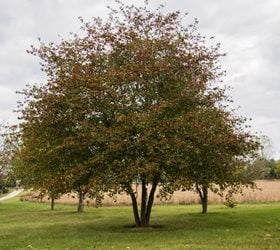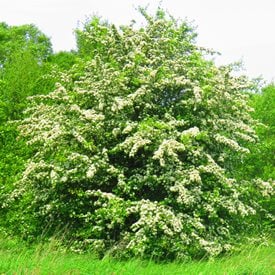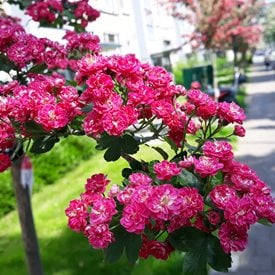GROWING AND CARING FOR HAWTHORN TREES
Multi-seasonal appeal and reliability are hallmarks of this common landscape plantSome plants such as hawthorn have stood the test of time, as evidenced by their common use in home and commercial landscapes. These small trees are grown for their four-season ornamental interest, sturdy nature, and tolerance of varying conditions. Native to temperate regions of North America, Europe, Asia, and North Africa, common names include quickthorn, thornapple, mayflower, whitethorn, and hawberry.
Hawthorn trees fall in the genus Crataegus, comprising hundreds of species in the Rose family (Rosaceae). Here’s how to grow and use hawthorn in the landscape, along with a list of common and garden-worthy varieties.
On this page: Basics | Planting | Care & Pruning | Choosing the Right Hawthorn | Pictures | Design
- HAWTHORN BASICS
- PLANTING HAWTHORN TREES
- CARE & PRUNING
- HOW TO CHOOSE THE RIGHT HAWTHORN
- HAWTHORN PICTURES
- DESIGN TIPS
HAWTHORN BASICS
Botanical name:
Crataegus
Zones:
3-9
Size:
15 to 50 feet tall and 8 to 35 feet wide, depending on variety
Forms:
Deciduous trees with upright spreading or bushy habits; some varieties can be kept as shrubs.
Exposure:
Full sun
Bloom Time:
Mid to late spring
Flowers:
Fragrant white or pink five-petaled flowers resemble apple blossoms.
Foliage:
Hawthorn tree leaves are green, toothed and often lobed, in varying shapes.
Fruit:
The fruits, which look similar to rose hips, are red, orange, yellow, or black. Classified as pomes—as with apples and pears—the fruits are produced in fall and persist through winter. The edible pomes, which have various culinary and medicinal qualities, are also an important food source for robins, waxwings, and other songbirds.
Deer resistance:
Crataegus species are fairly deer resistant, though if hungry enough, deer will forage plants they normally wouldn’t.
Are hawthorn trees invasive?
Singleseed or common hawthorn (C. monogyna) is considered invasive in many regions. This species is also called English hawthorn, not to be confused with C. laviegata, also referred to by the same common name. Plants are mainly spread through seeds.
PLANTING HAWTHORN TREES
When to plant:
Plant during milder months of spring or fall to avoid heat or cold stress.
Where to plant:
Choose a sunny site with well-draining soil.
How to plant:
Dig a planting hole 2 to 3 times wider than the diameter of the rootball and as deep. Add compost or manure to the planting hole* and dig it into the existing soil. Tease out roots if potbound, or make several slits in the rootball. Place plant in the hole with the top of the rootball slightly higher than the surrounding ground. Cover the sides, but not the top, of the rootball with loose soil and tamp down gently to remove air pockets. Water thoroughly and again once or twice weekly through the first growing season until established. If necessary, stake young trees to support against wind and to keep them growing straight.
*Note: It's best to add no more than 10% compost or manure (by volume) into the existing soil as it can impede good establishment when the roots reach the edge of the "nice" soil and need to grow beyond into the unamended native soil.
CARE & PRUNING
Watering:
Hawthorn is drought-tolerant once established. Water regularly during the first year and during prolonged heat or dry spells. Don’t overwater, as this can cause root rot and other fungal diseases.
Soil:
Hawthorns prefer well-amended soil that is fast-draining, but is tolerant of clay or sand. Soil pH should be between 6.0 to 7.5. Compacted soil or poor drainage can result in root rot.
Amendments & Fertilizer:
Hawthorns are light feeders. In spring, apply a slow-release fertilizer formulated for trees and shrubs according to instructions. Mulch with a layer of compost, pine straw, or bark chips (keeping away from the trunk) to conserve moisture and suppress weeds.
Pruning:
When pruning, use caution to avoid injury from the thorns. Wear heavy gloves, long sleeves, and goggles to protect your eyes. In late winter or early spring, remove damaged, diseased, or crossing branches and shape as needed. Cut back any suckers around the base of the trunk.
Diseases and pests:
Good cultural practices can help stem many problems. There are a number of pests and diseases that can affect hawthorns, though some varieties are more resistant than others. One of the most common and damaging diseases is fire blight. Other diseases include leaf spot, cedar hawthorn rust, powdery mildew, cankers and apple scab. Pests include borers, caterpillars, lacebugs, gall mites, aphids, leafminers, and scale.
HOW TO CHOOSE THE RIGHT HAWTHORN
With different sizes and forms of hawthorn to choose from, here are some tips to consider:
For borders and landscapes:
Choose varieties that will fit the scale of your property. Depending on the size and form, use as a stand-alone focal point, hedging, screening, or as foundation plantings. They can also be massed in the landscape or naturalized in a meadow setting. Make sure to allow room for plants to mature without becoming crowded.
For containers:
Plant a smaller specimen in a container for year-round appeal.
HAWTHORN PICTURES
DESIGN TIPS
There are many ways to incorporate hawthorn into your landscape. Here are just a few ideas:
- Use a single specimen as a focal point and underplant with small spring-blooming bulbs and groundcovers for multi-seasonal appeal.
- Plant English hawthorn or a native variety as a hedgerow in a meadow garden to provide food and shelter for songbirds and other wildlife.
- Plant hawthorn trees along a property line to act as a barrier hedge or living fence. The thorns will deter predators, while the dense growth will create a lush privacy screen.
- For a grand effect, plant a smaller tree form in a row on either side of a pathway to create an allée.
- Adorn a courtyard with an allée of hawthorns enclosed by a formal hedge of boxwood, barberry, or beech for an elegant statement.












